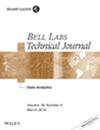Gianluca Boiocchi, Paolo Di Prisco, Ahmed Lahrech, Pierre Lopez, Maurizio Moretto, Paolo Volpato
下载PDF
{"title":"Next-Generation Microwave Packet Radio: Characteristics and Evolution Areas to Support New Scenarios in Wireless Backhauling","authors":"Gianluca Boiocchi, Paolo Di Prisco, Ahmed Lahrech, Pierre Lopez, Maurizio Moretto, Paolo Volpato","doi":"10.1002/bltj.21610","DOIUrl":null,"url":null,"abstract":"<p>The current generation of packet microwave was introduced to support the transport of Evolved High Speed Packet Access/Long Term Evolution (HSPA+ LTE) services in an all packet-based backhaul network. LTE Advanced (LTE-A) moves backhaul requirements even further, demanding more capacity and better performance. The scope of this paper is to discuss the main evolution areas of the next generation of packet microwave radios to support such new requirements. Discussion will touch on radio frequency (RF) capabilities necessary to increase radio capacity (e.g., high-order quadrature amplitude modulation (QAM), frequency reuse techniques, line-of-sight multiple input multiple output (LOS-MIMO)), improve energy efficiency (new RF technologies, smart metering methods), and decrease the form factor through mechanical arrangement. Packet functionalities of a packet microwave leverage RF capabilities, and provide a decisive step in supporting 10 Gb/s capacity and an increase in availability. A key role is played by the radio link aggregation group (LAG), coupled with the exploitation of adaptive modulation, to provide methods suitable for maximizing capacity and availability, and decreasing the overall solution cost. © 2013 Alcatel-Lucent.</p>","PeriodicalId":55592,"journal":{"name":"Bell Labs Technical Journal","volume":"18 2","pages":"143-157"},"PeriodicalIF":0.0000,"publicationDate":"2013-08-28","publicationTypes":"Journal Article","fieldsOfStudy":null,"isOpenAccess":false,"openAccessPdf":"https://sci-hub-pdf.com/10.1002/bltj.21610","citationCount":"5","resultStr":null,"platform":"Semanticscholar","paperid":null,"PeriodicalName":"Bell Labs Technical Journal","FirstCategoryId":"1085","ListUrlMain":"https://onlinelibrary.wiley.com/doi/10.1002/bltj.21610","RegionNum":0,"RegionCategory":null,"ArticlePicture":[],"TitleCN":null,"AbstractTextCN":null,"PMCID":null,"EPubDate":"","PubModel":"","JCR":"Q1","JCRName":"Engineering","Score":null,"Total":0}
引用次数: 5
引用
批量引用
Abstract
The current generation of packet microwave was introduced to support the transport of Evolved High Speed Packet Access/Long Term Evolution (HSPA+ LTE) services in an all packet-based backhaul network. LTE Advanced (LTE-A) moves backhaul requirements even further, demanding more capacity and better performance. The scope of this paper is to discuss the main evolution areas of the next generation of packet microwave radios to support such new requirements. Discussion will touch on radio frequency (RF) capabilities necessary to increase radio capacity (e.g., high-order quadrature amplitude modulation (QAM), frequency reuse techniques, line-of-sight multiple input multiple output (LOS-MIMO)), improve energy efficiency (new RF technologies, smart metering methods), and decrease the form factor through mechanical arrangement. Packet functionalities of a packet microwave leverage RF capabilities, and provide a decisive step in supporting 10 Gb/s capacity and an increase in availability. A key role is played by the radio link aggregation group (LAG), coupled with the exploitation of adaptive modulation, to provide methods suitable for maximizing capacity and availability, and decreasing the overall solution cost. © 2013 Alcatel-Lucent.
下一代微波分组无线电:支持无线回程新场景的特性和发展领域
当前一代的分组微波是为了在全分组回程网络中支持高速分组接入/长期演进(HSPA+ LTE)业务的传输而引入的。LTE Advanced (LTE- a)进一步提高了回程要求,要求更大的容量和更好的性能。本文的范围是讨论下一代分组微波无线电的主要发展领域,以支持这些新的需求。讨论将涉及增加无线电容量所需的射频(RF)功能(例如,高阶正交调幅(QAM),频率重用技术,视距多输入多输出(LOS-MIMO)),提高能源效率(新的RF技术,智能计量方法),并通过机械布置减少外形因素。分组微波的分组功能利用射频功能,在支持10gb /s容量和提高可用性方面迈出了决定性的一步。无线电链路聚合组(LAG)发挥了关键作用,结合自适应调制的利用,提供了适合最大化容量和可用性并降低整体解决方案成本的方法。©2013阿尔卡特朗讯
本文章由计算机程序翻译,如有差异,请以英文原文为准。

 求助内容:
求助内容: 应助结果提醒方式:
应助结果提醒方式:


